Genus Senecio Rank Species | Tribe Senecioneae Scientific name Senecio angulatus | |
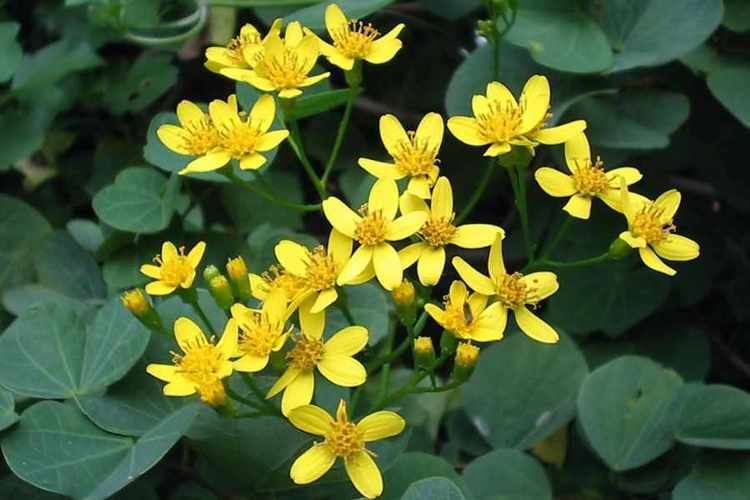 | ||
Similar Delairea, Senecio elegans, Senecio tamoides, Roldana petasitis, Senecio gallicus | ||
La hiedra del cabo senecio angulatus http riomoros blogspot com es
Senecio angulatus also known as Creeping groundsel and sometimes as Cape ivy is a climbing succulent perennial from the family Asteraceae of the genus Senecio; a native of South Africa an alien in Australia, a problem weed in New Zealand, naturalized in North Africa, and cultivated elsewhere.
Contents
- La hiedra del cabo senecio angulatus http riomoros blogspot com es
- Description
- Common names
- Distribution
- References
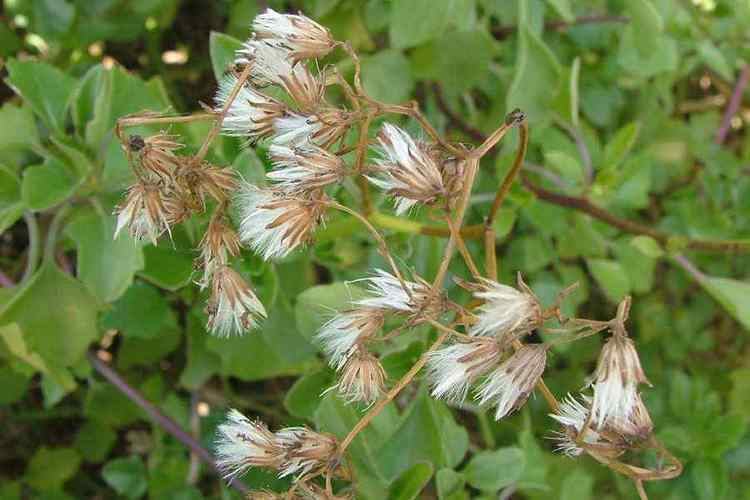
Senecio tamoides has been misapplied in Australia and is currently considered to be Senecio angulatus.
Description
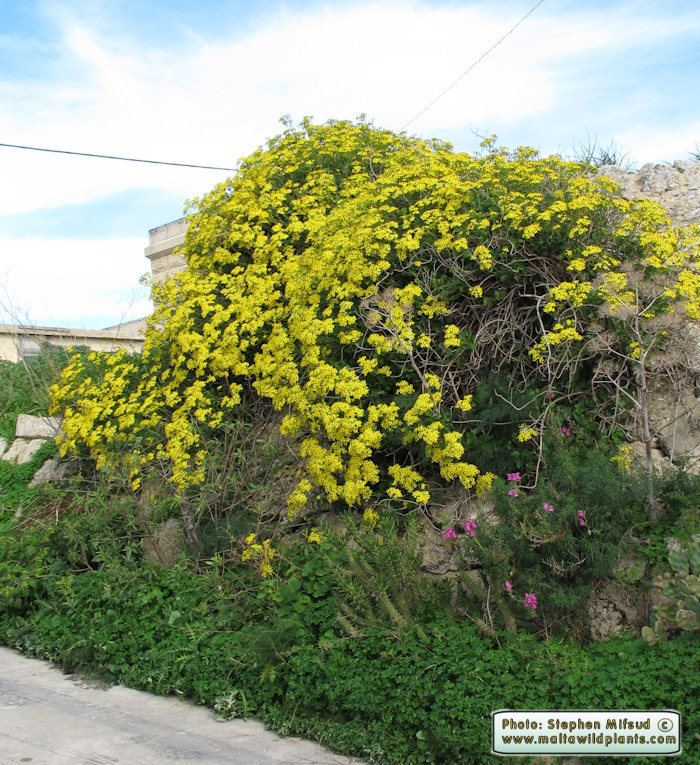
Described as scrambling and as a twining herb whose form is a dense tangled shrub 2 metres (6.6 ft) tall or a climber to 6 metres (20 ft) high, that can become an aggressive weed once established smothering the existing native vegetation both in the ground layer and canopy and altering the light climate in the invaded community and sometimes suppressing the regeneration of native plants.

Stems and leaves: Succulent, pale green stems, often variegated with pale yellow green and purple, slightly angular (not upright) and usually sparingly branched. Neither stems nor leaves are hairy.

Thick, glossy, fleshy, coarsely toothed leaves, with one to three teeth each side and bluntly lobed, with upper leaves becoming smaller with fewer teeth or none at all. Leaves are 3.7 centimetres (1.5 in) to 22 centimetres (8.7 in) long and 1 centimetre (0.39 in) to 14 centimetres (5.5 in) wide and occur in 1-4 pairs. Leaf stalks are 1 centimetre (0.39 in) to 4 centimetres (1.6 in) long. The leaves have stalks or stems which embrace the larger leaf surface which is not lobed, oval to triangularly shaped or very blunt to pointed at the tips and blunt to flat at the base. The leaves have a frosted look from a powdery coating on the lower side.
Senecio angulatus will climb if suitable support available.

It can be distinguished vegetatively from Senecio mikanioides by the lack of lobes at the leaf stalk base, the fleshy leaf surface, the outwardly curved leaf teeth.

Flowers: Senecio angulatus produces numerous flowers in open clusters at the end of its branches or stems. Strongly scented flowers on an elongated stem that continue to open in succession from the base up as the stem continues to grow; the mass of clusters ending more flat at the top than pyramid-like, 4 centimetres (1.6 in) to 8 centimetres (3.1 in) in diameter. Often the cluster droops with the flower heads at the end of the cluster turning upwards.
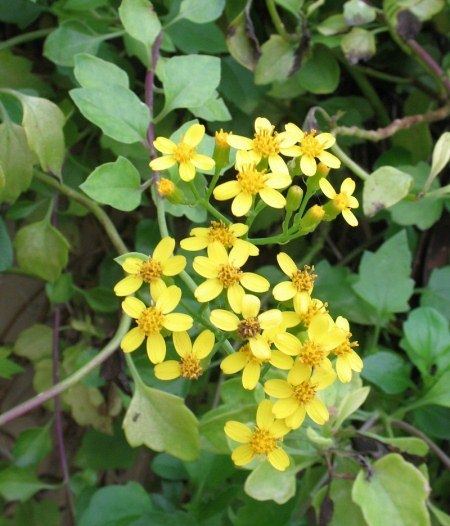
Flower stalks are mostly hairless or with some short hairs, 6.5 millimetres (0.26 in) to 10.5 millimetres (0.41 in) long. Flower heads are attached to flower stalk by fine pointed 8-11 bracts 5 millimetres (0.20 in) to 6 millimetres (0.24 in) which are surrounded by 4-7 pale green and sometimes purple tinged at the base supplementary bracts, 1.5 millimetres to 2.5 millimetres which make a cup shape around the base of the involucre. Each stalk is capable of producing 10-15 disc florets.
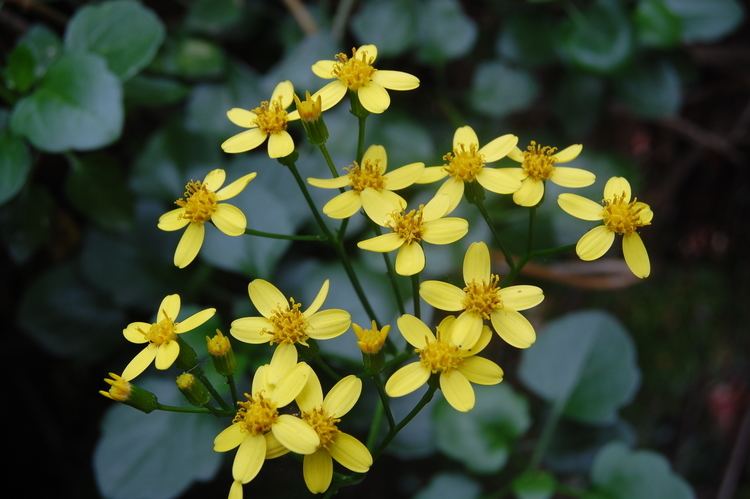
Flower-heads are radiate and urn-shaped, ray florets are nearly always absent yellow ligule when they occur. The corolla has a yellow disc surrounded by 4–6 dull golden yellow disc florets 5.5 millimetres (0.22 in) to 9.5 millimetres (0.37 in) long with hairless tubes, a slight expansion below the middle and lobes 1.3 millimetres to 2 millimetres wide.
Flowering from April to May in Africa and May to July in New Zealand; S. angulatus flower heads have rays (that look like petals) that make it more daisy-like unlike S. mikanioides which doesn't.
Fruits and reproduction: Creeping groundsel is easily dispersed by wind-blown seed, stem fragments, and dumped garden waste. Achenes are 3 millimetres to 4 millimetres long, ribbed or grooved with short hairs in the grooves and a tapering cylindrical shape. The parachute like hairs, the pappus, are 5 millimetres to 7 millimetres long.
Common names
Distribution
Preferring soils of black calcareous and grey sand, sandy clay and limestone; and finding homes with these soils in coastal areas on cliff faces, mudflats, wet depressions in dunes, near swamps, in landfills and scrubland and near settlements especially near the sea.
Native:
AfrotropicSouthern Africa: South AfricaCurrent
AfrotropicEast Tropical Africa: Uganda, Kenya, TanzaniaSouthern Africa: South AfricaAustralasiaWestern Australia: (Esperance Plains, Warren, Swan Coastal Plain), New South Wales, Victoria, Tasmania.New Zealand: New Zealand North, New Zealand South (Nelson City, Wairau Bar (Marlborough), Banks Peninsula)PalearcticMacaronesia: Canary Islands (Gran Canaria, Hierro, Tenerife), Balearic Islands (Ibiza, Formentera, Mallorca, Menorca)Southwestern Europe: Corsica, Channel Islands, France & Monaco, PortugalSoutheastern Europe: Italy, Sardinia, Sicily and surrounding islandsSources: GRIN, ALUKA, FBAF, NSWF, NZPND, BGB
